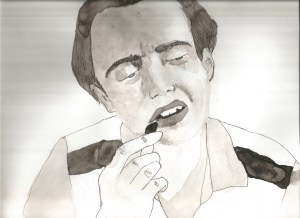Cropping Exercise




For these two exercises, I thought specifically about Barbara Kruger’s work. I decided to compose sections of the original photos in a narrative manner. For my first photo collage, I focused on the hands and feet of the two characters at odds to create what I think is an interesting composition.
The second tells a narrative, possibly of these men planning something sinister.
CORY ARCANGEL
As the combination of technology and fine art has become more prevalent, few contemporary artists have been able to manipulate technology quite as poignantly as Cory Arcangel. Having had a great deal of exposure in the past decade, he is know for the depth of his relationship with technology:
“He comments on digital media technologies and cultures while at the same time continuing to seek the possibilities that present themselves on the cutting edge of humor, theory and technological shortcomings. His interest in technology spans from the vernacular or non-expert to the conscious disrupting of digital techniques.”(EAI)
Arcangel’s early works revolve around game cartridge manipulation. Spanning from 2002-2005, Arcangel’s work experiments with “hacking” and the cultural significance of his technological medium.
The hacking process includes removing the plastic exterior of the game cartridge and cuts wires and solders areas to remove information from the chip. Arcangel then inserts his own chip with his own coding to add information into the game.
Super Mario Clouds(2002) is a modified cartridge of the game Super Mario Bros. for the Nintendo Entertainment System that was released in 1985, and possibly Cory Arcangel’s most well-known piece. The NES game cartridge is manipulated to only display the sky and clouds from the original, iconic gameplay. The blue sky and 8-bit pixelated clouds scroll left on the screen. Arcangel does not seem to have a concrete reason for his choices:
“I knew that the clouds would be simple enough for people to latch on to, and I knew that in order to make art that dealt with technology, you had to, in a way, have the art not directly be about specific technologies. I mean, we think everyone played Nintendo, but really, hardly anybody played Nintendo. Now looking back on it all – it’s about… what do these pixelated clouds represent? It represents the whole progression of humans, communication and technology. But I couldn’t write that down. And it became a meme slowly.”(Stuart)
Arcangel recognizes the clouds as an icon, but it does not necessarily talk about the medium or technology.
In the same year, Arcangel created I Shot Andy Warhol. This cartridge manipulation dealt specifically with the nature of the content of the manipulated game, in this case Hogan’s Alley(1984). Hogan’s Alley is not nearly as iconic as Super Mario Bros, but it uses the “light gun” expansion device released for the NES; This device allowed players to “shoot” objects on their television screen. The original game called for the player to shoot cardboard cut-outs of “gangsters” and to not shoot “innocents”. I Shot Andy Warhol replaces the “gangsters” with images of Andy Warhol, while the “innocents” are replaced by pop culture characters like Colonel Sanders, Flavor Flav, and the Pope. Not only does this refer to the infamous shooting of Andy Warhol, but the 1996 film of the same name. The piece mirrors the pop culture Warhol himself used in “a perfect example of a Warholian appropriation of pop culture. But instead of just watching, we get to participate in the process of the modern world eating itself”. The game allows Arcangel to kill his idol or “missing [the] target and keeping Warhol alive for eternity in our gaming consoles”.(Campbell)
2004 led to three game modifications that Arcangel has described as “totally maddening”(Arcangel). The first, Super Slow Tetris is, as title imples, is a modification of the NES game Tetris, but it has been slowed to the extent that it takes eight hours for one block to drop; However, the game is entirely playable. Space Invader, on the other hand, is a manipulation of the iconic Atari game Space Invaders which is adapted to have only one invader, making the game very difficult. Arcangel appears to have an interest in creating straining or tedious processes for the person interacting with his pieces. Continuing his experimentation with other kinds of games, F1 Racer was a modification of Japanese Famicon cartridge. Similarly to Super Mario Clouds, the racing game modification subtracted the car and all information other than the road and scenery that the player was intended to drive in.
The piece that seemed to conclude this era of Cory Arcangel’s work is Super Mario Movie. This almost 15-minute-long “movie” can be viewed by inserting the modified cartridge into the NES. The film creates a narrative about Mario as a character stranded in his own game. The movie includes the title screen of the original game Super Mario Bros. Text then appears as if it is apart of the game play that reads “AS A VIDEO GAME GROWS OLD ITS CONTENT AND INTERNAL LOGIC DETERIORATES”. This statement seems to sum up much of Arcangel’s work. The shot then depicts a parts from an early work entitled Totally Fucked, which just shows mario standing on a very small block of land, stranded for several minutes. The rest of the film shows Mario falling and interacting in a manipulated and digitally corrupt version of the game. The text begins to be corrupted and unintelligible and Mario is able to walk through areas without any ground beneath him. He appears alone in a broken and sad world, until he appears in the ending screen of the game, a bright grassy area.
Cory Arcangel’s work not only uses a technology in an interesting way, but it also sheds light onto the progression of technology and how we interact with it.
Video games in themselves have only been around for less than forty years. However, by 2002, Arcangel was able to use these cartridges that were 17 years old that were completely obsolete. Just as video games appear to still be emerging, they are still constantly progressing. The idea that the cartridges themselves and the mundane experience of playing a video game is what he has made into his art is the key element of his work. Cory Arcangel pushes the boundary of what can be a medium in art making and how to talk about technology today.
Arcangel, Cory. CoryArcangel. Familiar, 2002. Web. 16 Oct 2013. www.coryarcangel.com/things-i-made
Campbell, Marc. Dangerous Minds. 6 Aug 2012. Web. 16 Oct 2013. http://dangerousminds.net/comments/i_shot_andy_warhol_the_video_game
Electronic Arts Intermix. EAI, 1997. Web 16 Oct 2013. http://www.eai.org/artistBio.htm?id=7480
Stuart, Keith. “The Game of Art: a Profile of Digital Artist Cory Arcangel”. The Guardian, 4 Dec 2009. Web. 16 Oct 2013. http://www.theguardian.com/technology/gamesblog/2009/dec/04/games-art
interactive and participatory art [blog post 5]
The article by Meg Floryan discusses the evolution of participatory art. The author theorizes that the rise of participatory and interactive art seems logical at this time because we live in a culture that desires immediacy. Viewers also seem to respond to a concept more when they are able to discover it in a kinesthetic way. There are also many using social media and due to its cultural relevance and the ease of spreading information to multiple viewers. The article specifically talks about Marina Abromovic, possibly one of the most well known performance artists, and her many cathartic and groundbreaking works. The rise of participatory work has allowed museums to question what exactly an installation or exhibition is.
In the past two years, I have dealt more with interactive works. Though, I find the most difficult aspect to participatory art is to create a piece that, without explanation, viewers have a desire to interact with. We have been trained to not touch things in a gallery; it is instilled in us that art is precious and delicate and not to be fooled-around with. However, as artists take their work more towards participation, we have to train viewers to know how to participate. Something about the work has to entice the participant without being didactic or having to immediately provide an artist statement.
What is “Postdigital”? [blog post 4]
Many theorists and artists are dealing with and talking about the concept of the term “postdigital”. This term describes the our relationship digital media and how it is constantly changing; particularly since the turn of the century. The 2011 documentary PressPausePlay heavily deals with popular artist, musicians, writers, and filmmakers’ processes in handling this new found realization that digital media is, and has been, a part of our lives. Writer and filmmaker, Lena Dunham, discusses the ideal way of becoming a hit filmmaker in the documentary. She talks about the dream of the linear path to success being obsolete due to digital media and the extreme access we have; this aids in the accessibility of making films, but makes it more difficult to be discovered.
The postdigital age seems to be the fact that we no longer find it a privilege or remarkable that we can have access to photoshop, we can have artist websites, and other technologies are at our fingertips. However, Lena Dunham’s interview brings about the very pressing issue for young artists that comes along with this accessibility: how to be visible in the sea of other artists. As an art student, I have access to things that could make my artwork, and whatever digital medium I choose to share it on, entirely compelling, but so can anyone else. But because of this, exposure in the art world is no longer how many exhibitions you are a part of, but more so if your work is a featured post on tumblr. Artists aren’t making work for the intention of being seen in galleries, but being viewed as jpegs.
Last Spring semester, I started making short appropriation videos. Out of the ten I made during the semester, I used one called Basement in my pre-exhibit review. This video was really more of an exercise in editing for me, but it was also able to talk about sexuality and gender.
After video didn’t pan out as a medium I wanted to work with, I moved to illustration. I also started drawing from the videos I had made.

For this upcoming project, I am looking to use elements of both of these pieces to remediate one another
Convergence Culture [blog post 2]
Henry Jenkins’ Convergence Culture: Where Old and New Media Collide talks about “the relationship between three concepts – media convergence, participatory culture, and collective intelligence.” Jenkins’ describes how today multiple forms of media interact to create the content audiences ask for. There are also two types of cultural convergence; “Top-down” cultural convergence describes media being produce by corporations and “bottom-up” convergence is when content is demanded by the consumer. Participatory culture refers to the audience expected to interact with the media. While collective intelligence is the combination and circulation of knowledge through this large scale audience participation.
Today, it is almost impossible to find a marketing campaign that does not use multiple forms of media. For example, social media has become incredibly prominent in reality television. You can now tweet your vote for your favorite contestant on America’s Got Talent. America’s Next Top Model even factors in a “social media score” into the evaluation of what contestant is going to be eliminated from the competition. Some forms of media colliding today could not be more different. The Spanish horror film REC (2007) was advertised through a partnership with the online video game Second Life. An area was created for users’ avatars to interact with that was a replica of an area with in the movie. Combining forms of media has become an extremely affective and, seemingly, a part of our culture that is not going away.
Send [blog post 1]
The introduction and first chapter of David Shipley and Will Schwalbe’s Send discusses emailing and how it is abused and misused. From political scandals to the authors’ own experience with their editor, they write on several examples of email mishaps and their potential consequences. The two main points provided in the reading for why email is particularly challenging for us are email’s “inherent absensce of tone” and “its ability to simulate forward motion.” The writers even argue that email is the most tricky form of digital communication. However, despite these shortcomings, email is vitally important and isn’t going away.
I feel email, and some other forms of electronic communication, are often times either over or under thought; both potentially being hazardous. An over-thought email can cause some rigid and unnecessary formalities. Under-thought emails are probably more of an issue of many people not fully understanding emailing; though, I assume the rest of Send probably attempts to remedy some of those misunderstandings. A co-worker recently told me a terrible example of emails-gone-wrong from an email she sent a professor. Unfortunately, my co-worker had made small a grammatical error (some kind of your/you’re or there/their/they’re situation) in her email. This prompted her professor to forward the email to a colleague and added how stupid my co-worker and the other students she had to deal with were. However, the professor didn’t realize forwarding the email allowed my co-worker to see the professor’s insulting correspondence with her colleague. Much to her professor’s embarrassment, My co-worker brought this to her professor’s attention which resulted in a very lengthy apology.
Small digital communication mistakes can become large faux-pas especially in the academic and professional worlds. The internet and digital communication have obviously become too important and it is our responsibility to fully understand how it works and the etiquette that comes along with it.
remediation/reverse remediation/aesthetic experience [blog #3]
“Aesthetic Experience and the Importance of Visual Composition in Information Design” by Tim Greenzweig describes some the fundamental and overlooked values of information design and how they affect a viewers experience. This article talks about organizing information in a visually appealing way for a webpage or other types of digital media.
“Remediation” and “reverse remediation” refers to old media informing new media and vise-versa. In “Dynamic Stasis”, by media theorist Richard Grusin, describes the title of Nathaniel Stern and Jessica Meuninck-Ganger’s series of work as referring to the dynamic aspect of motion involved in their pieces, but also the stationary stasis of the traditional print media used.
It seems to me combining-new-media-with-old-media is kind of a standard problem-solving or content-building practice many artists tend to work with. However, integrated the ideas in Dynamic Stasis of remediation into the aesthetic experience of information design appeals to me a bit more as an element in digital design. When asked to design a background or header for a webpage, I don’t really prefer sleek modern-looking designs. I think it adds a certain amount of depth to have what is clearly a hand-rendered design within in a very modern interface. A webpage can still look personal and gestural through the usage of traditional and digital media.